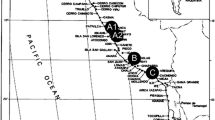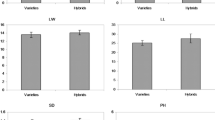Abstract
Seed set over three years in crosses between three tritordeums used as female parents and four triticale lines, showed that there are significant differences in crossability attributable to both parents and that most of these differences are consistent over the three years. When used as the female parent tritordeum line HT67 had an average seed set of 29.62%, tritordeum line HT9 an average of 12.73%, and tritordeum line HT31 an average of only 6.58% averaged over the four triticales lines used as pollinators. These data show genotype effect that is highly significant (P < 0.001) both for tritordeum and triticale genotypes and highly significant (P < 0.001) female ×year, male × year and female × pollinator interactions. The behaviour of F1 tritordeum hybrids when crossed with one of the triticale pollinators supports the conclusion that the parents' crossability behaviour is genetically controlled. Analysis of segregation ratio of F2 hybrids plants from high and low crossability tritordeum genotypes crossed with the same triticale pollinator genotype is consistent with 9:3:3:1 ratio.
Similar content being viewed by others
References
Falk, D.E. & K.J. Kasha, 1981. Comparison of the crossability of rye (Secale cereale) and Hordeum bulbosum. Can J Genet Cytol 23: 81-88.
Falk, D.E. & K.J. Kasha, 1983. Genetic studies of the crossability of hexaploid wheat with rye and Hordeum bulbosum. Theor Appl Genet 64: 303-307.
Fedak, G., 1992. Intergeneric hybrids with Hordeum. In: P.R. Shewry (Ed.), Barley: Genetics, Biochemistry, Molecular Biology and Biotechnology, pp. 45-68. C.A.B. International, The Alden Press Ltd, Oxford, U.K.
Fernández-Escobar, J. & A. Martin, 1989. A self-fertile hybrid in the Triticeaeinvolving Triticum, Hordeumand Secale. Euphytica 42: 291-296.
Finch, R.A. & M.D. Bennett, 1980. Mitotic and meiotic chromosome behaviour in new hybrids of Hordeumand Triticumand Secale.. Heredity 44: 201-209.
Guedes-Pinto, H., 1991. Triticale × rye crossability. Proc of 2nd Triticale Symp. México, D.F., CIMMYT, 150-153.
Guedes-Pinto, H. & M. Bernard, 1983. Étude comparative de quelques cultivars de blé, seigle et triticale dans le nord du Portugal. I. Production de grain, de paille, de protéines. Agronomie 3: 691-700.
Guedes-Pinto, H., O. Carnide & V. Carnide, 1984. New primary triticales for Portugal. I. Obtention of amphiploids. Brotéria Genética 5 (80): 139-146.
Guedes-Pinto, H., V. Carnide, A. Afonso & A.F. Silva, 1991. Triticale farm evaluation experiments in northern Portugal. Proc of 2nd Triticale Symp, México, D.F. CIMMYT, 636-639.
Inagaki, M. & M. Tahir, 1990. Comparison of haploid production frequencies in wheat varieties crossed with Hordeum bulbosumL. and maize. J J Breed 40: 209-216.
Krolow, K.D., 1970. Untersuchungen uber die Kreuzbarkeit zwischen Weisen und Roggen. Z Pflanzenzüchtg 64: 44-72.
Lange, W. & B. Wojciechowska, 1976. The crossing of common wheat (Triticum aestivumL.) with cultivated rye (Secale cerealeL.). I. Crossability, pollen grain germination and pollen tube growth. Euphytica, 25: 609-620.
Laurie, D.A. & M.D. Bennett, 1987. The effect of crossability loci Kr1 and Kr2 on fertilization frequency in hexaploid wheat × maize crosses. Theor Appl Genet 73: 403-409.
Lein, A., 1943. Die genetische Grundlage der Kreuzbarkeit zwischen Weizen und Roggen. Z. Indukt. Abstamm-Vererbungsl 81: 28-61.
Martin, A., A. Martinéz-Araque & J. Ballesteros, 1996. Tritordeum: Triticale' s new brother. In: H. Guedes-Pinto et al. (Ed.), Triticale: today and tomorrow, pp. 57-72. Kluwer Academic Publishers, The Netherlands.
Oettler, G., 1983. Crossability and embryo development in wheat rye hybrids. Euphytica 32: 593-600.
Riley, R. & V. Chapman, 1967. The inheritance in wheat crossability with rye. Genet Res 9: 259-267.
Snape, J.W., V. Chapman, J. Moss, C.E. Blanchard & T.E. Miller, 1979. The crossabilities of wheat varieties with Hordeum bulbosum. Heredity 42: 291-298.
Stich, L.A., J.W. Snape & S.F. Firman, 1985. Intrachromosomal mapping of crossability genes in wheat (Triticum aestivum). Theor Appl Genet 70: 309-314.
Tanner, D.G. & D.E. Falk, 1981. The interaction of genetically controlled crossability in wheat and rye. Can J Genet Cytol 23: 27-32.
Zeven, A.C. & C. van Heemert, 1970. Germination of pollen of weed rye (Secale segetaleL.) on wheat (Triticum aestivumL.) stigmas and the growth of pollen tubes. Euphytica 19: 175-179.
Author information
Authors and Affiliations
Rights and permissions
About this article
Cite this article
Lima-Brito, J., Guedes-Pinto, H. Crossability between tritordeum and triticale. Euphytica 104, 107–111 (1998). https://doi.org/10.1023/A:1018639423760
Issue Date:
DOI: https://doi.org/10.1023/A:1018639423760




